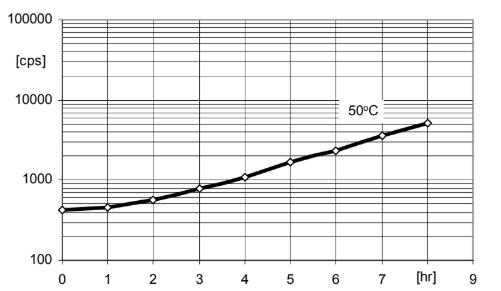Enhanced TDS
Identification & Functionality
- Chemical Family
- RTU Product Type
- Technologies
- Product Families
Features & Benefits
- Ready-to-Use Product Features
- Product Features
- Exhibit good UV resistance
- Retain good clarity & light transmission at elevated temperature
- Offer good crack resistance
- Adhere to leadframe and housing firmly
Applications & Uses
- Compatible Substrates & Surfaces
- Composites Processing Methods
- Product End Uses
- System Preparation
- Pre-Mixing: Component A to be preheated at 60°C/30min
- Mixing: The mixture of component A/component B may be mixed using standard techniques.
- Degassing: Use vacuum device; 0 - 10 mmHg
- Application Information
- Applicable for blue and white LED
- Applicable for chip and high power LED
Properties
- Physical Form
Regulatory & Compliance
- Certifications & Compliance
Technical Details & Test Data
- Typical Cured Information

Fig 2: Viscosity increment at 50⁰C
Initial viscosity BH type Viscometer 20 rpm at 25⁰C : 2600 cps
Recommended cure schedule
LED Type Cure Step Temperature Time Chip LED 1st Step Cure 130°C 1 hour Post Cure 150°C 5 hours Lamp LED 1st Step Cure 110°C 1 hour 2nd Step Cure 120°C 0.5 hours Post Cure 150°C 5 hours Note: Actual oven cure is dependent upon applications and substrate/component design.
Specimen cured at 130°C for 1 hr and 150°C for 5 hr
Property Test Method Test Values Unit At Condition Glass Transition Temperature (Tg) DSC 125 °C - Coefficient of Thermal Expansion - 58 ppm Below Tg 149 ppm Above Tg Hardness (Shore D) ASTM D-2240 88 - - Flexural Strength ASTM D-790 15.08 kg/mm² 25°C Flexural Modulus ASTM D-790 282.5 kg/mm² 25°C Shrinkage - 0.97 % - Water Pick-Up (Boiling at 100°C for 24 hours) ASTM D570 0.16 % - Boiling for 24 hours - 1.76 % - Volume Resistivity ASTM D257 1.11 x 10¹⁶ Ω·cm - Dielectric Constant ASTM D150 3.01 - 1 MHz Dielectric Loss ASTM D150 1.93 % 1 MHz Refractive Index Wavelength (nm) Refractive Index Unit At Condition 486 1.547 - - 588 1.537 - - 658 1.534 - - Transmittance (2mm Thickness)
Wavelength (nm) Transmittance Unit Test Condition 400 80.84 % 2mm thickness 500 84.22 % 2mm thickness 600 84.45 % 2mm thickness 700 87.05 % 2mm thickness Transmittance (UV Resistance after 365nm, 30mW/cm² for 1000 hours)
Wavelength (nm) Transmittance Unit Test Condition 400 61.02 % 365nm, 1000 hours
500 78.19 % 365nm, 1000 hours
600 81.94 % 365nm, 1000 hours
700 85.02 % 365nm, 1000 hours
Transmittance (Heat Resistance at 120°C for 1000 hours)
Wavelength (nm) Transmittance Unit Test Condition 400 71.52 % 120°C, 1000 hours
500 82.88 % 120°C, 1000 hours
600 84.42 % 120°C, 1000 hours
700 87.32 % 120°C, 1000 hours
Safety & Health
- Handling Precautions
Mandatory and recommended industrial hygiene procedures should be followed whenever our products are being handled and processed.
Storage & Handling
- Storage Conditions
The components have to be stored under dry conditions below 25°C, in tightly sealed original containers. Under these conditions, the shelf life will correspond to the expiry date stated on the label. After this date, the product may be processed only following reanalysis. Partly emptied containers should be closed tightly immediately after use.Disposal - Regular procedures approved by national and/or local authorities
